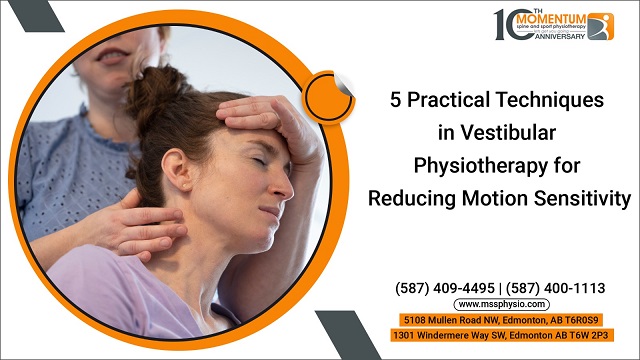Motion sensitivity can significantly impact daily life, leading to dizziness, nausea, and imbalance during activities like walking, driving, or quick head movements. Vestibular physiotherapy in Edmonton offers effective techniques to address these issues by focusing on the vestibular system, which plays an important role in maintaining balance and spatial orientation. In this therapy, vestibular rehabilitation techniques are utilized to help individuals adapt and reduce their sensitivity to motion. This approach, known as vestibular rehabilitation therapy, incorporates exercises and strategies aimed at retraining the brain and body to handle movement better, ultimately reducing symptoms and improving overall quality of life.
1. Habituation Exercises
Habituation exercises play a key role in vestibular rehabilitation therapy by reducing motion sensitivity through repeated exposure to movements that typically trigger symptoms. These exercises work by desensitizing the body to specific motions, decreasing the intensity of dizziness and discomfort over time. A gradual approach is taken to help the brain adapt, reducing its response to these stimuli.
One common habituation exercise is the Brandt-Daroff Exercise. This exercise is done by starting in a seated position on the edge of a bed with feet flat on the floor. Then, quickly lie down on one side, angling the head upward at a 45-degree angle as if looking at the ceiling. This position is held for about 30 seconds or until any dizziness subsides. Returning to the sitting position for 30 seconds before repeating the motion on the opposite side completes one cycle. Performing this exercise in sets, as recommended by a vestibular physiotherapist, can help the brain become accustomed to these movements, effectively reducing motion sensitivity over time.
2. Gaze Stabilization Techniques
Gaze stabilization exercises are crucial for enhancing eye movement control during head movements, an important factor in reducing motion sensitivity. The focus of these exercises is to strengthen the vestibulo-ocular reflex (VOR), which maintains visual stability when the head moves. When the VOR is not functioning properly, dizziness and visual discomfort can occur. Vestibular physiotherapy in Edmonton commonly incorporates these techniques to improve the function of the VOR.
An example of a gaze stabilization exercise is the VOR x1 exercise. This involves focusing on a fixed point, such as a small letter or symbol on the wall, while moving the head side to side or up and down at a controlled pace. The goal is to keep the target in clear focus throughout the movement. Starting with slow head movements and gradually increasing speed helps in building tolerance. Regular practice of this will lead to a significant reduction in symptoms of motion sensitivity during everyday activities.
3. Balance Training Exercises
Balance training is an integral part of vestibular rehabilitation therapy, aimed at enhancing the body’s ability to maintain stability in various positions and movements. These exercises work on improving coordination between the vestibular system, muscles, and joints, which is crucial for reducing motion sensitivity. Techniques such as standing on one leg, walking heel-to-toe, and using balance boards challenge the vestibular system and help improve overall coordination.
A simple and effective exercise for improving balance is standing on one leg. Begin by standing near a sturdy surface for support. Lift one foot off the floor. Balance on the other leg for about 20-30 seconds. To increase the challenge, this can be done with eyes closed or on a softer surface. This exercise strengthens proprioception and balance control, making the vestibular system more resilient to movements that might otherwise cause dizziness or instability. Consistent practice of balance exercises is shown to reduce motion sensitivity and significantly improve confidence in daily activities.
4. Positional Maneuvers
Positional maneuvers, such as the Epley or Semont maneuver, are performed by a physiotherapist to treat conditions like benign paroxysmal positional vertigo (BPPV), which can lead to motion sensitivity. During the Epley maneuver, the physiotherapist guides the individual through a series of specific head and body movements. The process starts with the person sitting on the edge of a bed. The physiotherapist then assists in quickly lying the person back with the head turned 45 degrees toward the affected ear. After holding this position, the physiotherapist carefully turns the head 90 degrees to the opposite side, followed by rolling the person onto the side that the head is now facing. Each position is held for about 30 seconds to allow the inner ear crystals to settle. By performing these movements, the physiotherapist helps reposition the crystals in the inner ear, providing relief from dizziness and reducing motion sensitivity.
5. Functional Movement Training
Functional movement training is an active component of vestibular rehabilitation therapy that the individual can perform. This training involves practicing real-life movements to help the vestibular system adapt and reduce motion sensitivity. For example, the individual might practice walking through a crowded area, turning quickly in different directions, or navigating up and down stairs. By simulating these everyday scenarios, the brain learns to process motion better and maintain balance, making these tasks easier and less likely to trigger symptoms. This practice helps the individual gain confidence in handling daily activities, thereby reducing the overall impact of motion sensitivity on daily life.
Reducing Motion Sensitivity with Momentum Physiotherapy
At Momentum Physiotherapy Ed, addressing motion sensitivity through effective vestibular rehabilitation techniques can significantly enhance daily functioning and quality of life. If persistent motion sensitivity is impacting daily activities, consider seeking vestibular physiotherapy in Edmonton to explore personalized treatment options. Taking a step toward vestibular rehabilitation can pave the way for a more balanced and comfortable life. Reach out to Momentum Physiotherapy to begin the journey toward managing and reducing motion sensitivity.

